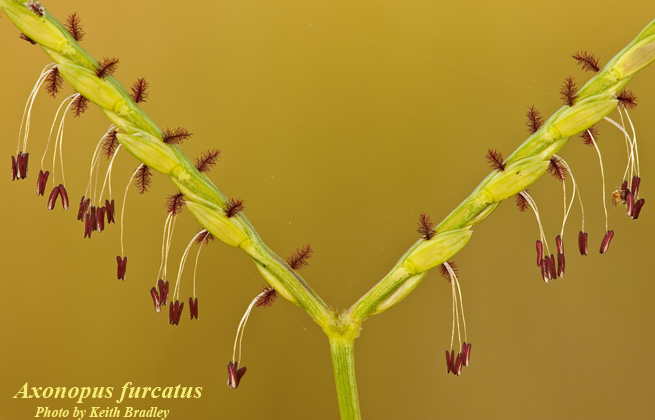Difference between revisions of "Axonopus furcatus"
(→Distribution) |
(→Ecology) |
||
| Line 31: | Line 31: | ||
==Ecology== | ==Ecology== | ||
| − | ===Habitat=== <!--Natural communities, human disturbed habitats, topography, hydrology, soils, light, fire regime requirements for removal of competition, etc.--> | + | ===Habitat=== |
| + | "A. furcatus" can be found in maritime forests, sandy forest, bottomlands, calcareous wet meadows and other coastal regions. <ref name= "Weakley"> [Weakley, A. S. (2015). Flora of the Southern and Mid-Atlantic States. Chapel Hill, NC, University of North Carolina Herbarium.]</ref> | ||
| + | <!--Natural communities, human disturbed habitats, topography, hydrology, soils, light, fire regime requirements for removal of competition, etc.--> | ||
<!--===Phenology===--> <!--Timing off flowering, fruiting, seed dispersal, and environmental triggers. Cite PanFlora website if appropriate: http://www.gilnelson.com/PanFlora/ --> | <!--===Phenology===--> <!--Timing off flowering, fruiting, seed dispersal, and environmental triggers. Cite PanFlora website if appropriate: http://www.gilnelson.com/PanFlora/ --> | ||
<!--===Seed dispersal===--> | <!--===Seed dispersal===--> | ||
Revision as of 14:53, 16 May 2018
| Axonopus furcatus | |
|---|---|

| |
| Photo by the Atlas of Florida Plants Database | |
| Scientific classification | |
| Kingdom: | Plantae |
| Division: | Magnoliophyta - Flowering plants |
| Class: | Liliopsida - Moncots |
| Order: | Cyperales |
| Family: | Poaceae |
| Genus: | Axonopus |
| Species: | A. furcatus |
| Binomial name | |
| Axonopus furcatus (Fluegge) Hitchcock | |
Contents
Taxonomic Notes
Synonym: Paspalum furcatum (Flügge)
Varieties: none
Description
A. furcatus is a perennial graminoid of the Poaceae family native to North America. [1]
Distribution
The "A. furcatus" is found along the Coastal Plains of Virginia to Florida and west to Texas and Arkansas. [1]
Ecology
Habitat
"A. furcatus" can be found in maritime forests, sandy forest, bottomlands, calcareous wet meadows and other coastal regions. [2]
Conservation and Management
Cultivation and restoration
Photo Gallery
References and notes
- ↑ 1.0 1.1 USDA Plant Database
- ↑ [Weakley, A. S. (2015). Flora of the Southern and Mid-Atlantic States. Chapel Hill, NC, University of North Carolina Herbarium.]